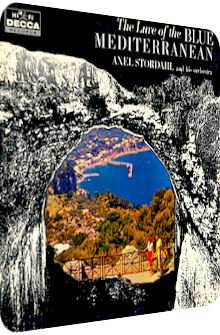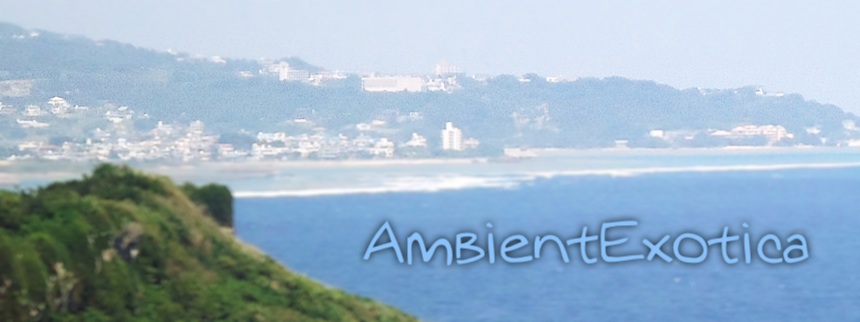
Axel Stordahl
Lure Of The Blue Mediterranean
1959
The American composer and trumpeter with Norse roots, Axel Stordahl (1913–1963), is probably best known for his time-consuming and perennial work with Frank Sinatra. With the help of Stordahl (among others), Sinatra is catapulted to the higher regions of the music charts quite often. This successful collaboration lasts for several years, but on the brink of the Exotica craze, Stordahl is asked by the management of Decca Records whether he would like to jump on the bandwagon and flesh out a mixture of classic and unique material that implicates the growing trend of tourism as well.
Stordahl decides to come up with a concept that has already been proved as marketable in 1956: heavyweight John Scott Trotter’s symphonic Escape To The Magic Mediterranean is a great success and borrows from many countries, timbres and styles one year before the term Exotica is even coined. Stordahl decides to give it a go as well. He copies the concept of Strotter, true, but he does it with style. The Lure Of The Blue Mediterranean is released in 1959, nowadays often misnamed as Lure Of The Blue on the net. It is Axel Stordahl’s first true Exotica release where the genre concept is realized in the usual twelve tracks. However, four of the twelve tracks are unique compositions that were specifically written by the well-known composer for this release, and only the classic Misirlou is found on both Strotter's and Stordahl's LP. Another unique selling point – especially in regard to the low-budget release flood on Decca Records – is the eleven-page booklet that is cleverly integrated into the packaging of the LP.
The white rocks (blue on some versions) on the front artwork are the actual cover in the form of a cardboard overlay, and the picture of the lovebirds in front of a picturesque fishing village is in fact the first page of that very booklet full of Tunisian landscapes and Italian coves. As the Mediterranean Sea touches more than 40 countries, a huge stylistic variety of the audio material is justifiable. Stordahl, however, plays it safe by interweaving the strings into all of his tracks, with the occasional flying visit of Oriental territories. If you feel a certain yearning in your heart and don’t shy away from Easy Listening or symphonic works, please read on.
Majorca Isle Of Love is the first destination on the journey, and it’s based on Bob Manning’s 1955 hit of the same title. With 4 minutes and 15 seconds, it’s a surprisingly long piece of conviviality that consists of mellifluous flute tones that are underlined with glockenspiel droplets and a downspiraling seven-note motif on sweeping strings. The clichéd castanets have to be in there, of course, but there are also genuinely wonderful inclusions that enhance the given context, for instance the scattered harp melodies that are prominently featured and allowed enough room to gleam on their own or in the adjacency of the smoothened trumpet, a signature inclusion in each of Stordahl’s orchestral productions. All in all, Majorca Isle Of Love provides the pleasant anticipation and positive tension of a paradisiacal trip. It is saccharine and overly joyful, but this is both expected and mandatory in regard to exotic travelog albums.
From the vantage point of Majorca, the Isle Of Capri isn’t that far. Originally written by Hugh Williams in 1934 and sung by such illustrious stars as Gracie Fields or Frank Sinatra, Stordahl’s version is particularly dreamy due to the intimate acoustic guitar twangs which are heard incessantly throughout the composition, the cascading five-note brass breeze that wafts in the distance and the almost baroque nature of the sun-soaked violins. A silky trumpet is yet again in the limelight and accompanied by sugary staccato violas. I have to admit that Isle Of Capri is very kitschy, but the juxtaposition of the lonesome guitar with the auroral violin washes works well enough and injects sunny landscapes into the interplay.
The following Tunis: Ports Of Call is a special gem, if only due to the fact that it’s a unique piece written by Stordahl himself. As its auspicious title already suggests, the mood gets much more Oriental. The trumpet is played in higher regions and mimics a shawm, sizzling-hot but dubious strings augment the murky scene, and clinging tambourins fill in the gaps in-between the instruments. There is not much else to this song other than the faux-shawm. It carries the whole anthem of mystery, and it is refreshing to see the phantasmagoria of the strings reduced in favor of a dense gloominess. Definitely one of the best tracks on here that fends off the sweetness of the previous offerings to great success.
While Cyprus, another unique composition by Stordahl, presents gorgeous Les Baxter-like string washes, a jazzy double bass-heavy base frame that morphs into the most frantic bongo-fueled rhythm complete with brass eruptions and saltatory high-rise flutes, Red Sails In The Sunset, another song by Hugh Williams, brings back the dreaminess with eminently sleek alto flutes, high violin accompaniments, a carefully interwoven bongo percussion and effervescent streams of strings. Side A finishes with a blast as it ends with Haifa, a melodramatic rendition of the traditional Hebrew folk song Hava Nagila thanks to its galloping rhythm and related tempo shifts, marvelously gleaming sunset trumpets and hidden xylophone sprinkles. This is one of the catchier interpretations out there, and surprisingly dynamic and fulminant in comparison to the overarching concept.
Side B launches with Alessandro Cicognini’s Autumn In Rome. A previously unheard instrument underlines the melancholic heaviness of the song and elevates itself to the foreground quite often: the piano, whose chords merge well with the lamenting trumpet melody, the quavering strings and dreamy harp spots. Once a multitude of balmy flutes is entering, the majesty of the song changes and gets much brighter, therefore remaining close to the Easy Listening formula.
Up next is the fitting foil to Hava Nagila, the mandatory Misirlou. Stordahl’s version is based on a pompously dark brass backing, resonating string washes and a wonderful inclusion of a fantastically evenfall-encapsulating Greek folk guitar – a genuine surprise! Glockenspiels, mercurial flutes and spectral shawm-mimicking trumpets complete this tremendously catchy rendition. Palermo: Ports Of Call is yet another one of Stordahl’s compositions that are specifically written for this album, and he succeeds in offering a different mood, as the strings on this composition are on steroids, or so it seems: they glow in technicolor, play the eclectic melody which contains occasional traces of O Sole Mio, and take over the whole composition due to their illuminative power. Another poignant inclusion is based on the various cymbals that boost the dynamic further. This piece is without a doubt one of the most staggering, lively and colorful parts of the whole LP.
While Off Shore by Leo Diamond and Michael Goldsen is a splendid downbeat skit with a jazzy double bass backing, but otherwise integrates orchestral ingredients like hummable violin melodies and enchanting brass harmonies, Stordahl’s last unique composition Riviera Pavanne floats between a 3/4 Waltz solemnity with bubbly string eruptions and a much more dreamful phase of charming brethren which whirl and flow quaintly through the aural landscapes that lead to the final A Night In Tunisia. Originally written by Dizzy Gillespie in 1942, the Jazz factor is curiously expanded with this last track that is far off the previous reveries, but nonetheless welcome, as its swinging catchiness is undoubtedly vitalizing: double bass backings, piano glitters, improvisations on the vibraphone as well as big band ingredients such as horns and cymbals make this a delicate Jazz/Big Band/Orchestra hybrid that is both energizing and streamlined – none of the instruments really takes over, and thus, everything is well balanced. A very good closing track, even though it breaks the formula of the previous eleven compositions.
Axel Stordahl’s first Exotica album is a success. It resides clearly in Easy Listening territories, but the dynamics of traveling and seeing different places are interwoven really well in both the album artwork and the music itself. An enjoyable amount of compositions is unique, showing Stordahl’s skills as a composer. But even the classic or traditional material is vividly painted and conducted, with the various rhythm-related shifts causing pizzazz and verve. The first two opening tracks might admittedly be syrupy and all too bright, but fear not, for the enigmatic Oriental tunes provide a great counterpoint to the sunnier material without breaking the mood or alienating the listener all too much.
Easy Listening fans will enjoy this album tremendously, and even Exotica fans who long for the more intimate sound delivered by trios or quartets will be fond of the occasional inclusion of bongos as well as the shawm-like performance on the trumpet. The Lure Of The Blue Mediterranean is, at least in my book, as terrific as John Scott Trotter’s Escape To The Magic Mediterranean, even though the latter is slightly more diversified thanks to additional instruments such as the accordion and further exotic percussion. Still, I simply cannot pinpoint the better album; from an aesthetic viewpoint, both shift between Western and Oriental material, with many clichéd curlicues of Spain and Italy thrown in.
From a conceptual viewpoint, both albums rely on the yearning of the listener, as the composers jump from island to island, from port to city, from sunrise to twilight, from desert to tavern, and back again. Both albums are luckily available on digital music stores and streaming services, so they are readily at hand for consumption. Naturally, the real attraction of both albums relies on the synergy between front artwork and music, not just the music itself, but the latter leaves a strong impression on its own. If you are searching for exotic string orchestra music that calls Easy Listening its home, but surprises with rhythmic changes and a potpourri of classics and unique compositions – a selling point that Strotter cannot offer –, give Axel Stordahl’s The Lure Of The Blue Mediterranean a chance, not to mention any of his additional Exotica albums – did anyone mention 1960's Jasmine & Jade and 1961's The Magic Islands Revisited? – that are also worth owning.
Exotica Review 095: Axel Stordahl – The Lure Of The Blue Mediterranean (1959). Originally published on Jul. 21, 2012 at AmbientExotica.com.
